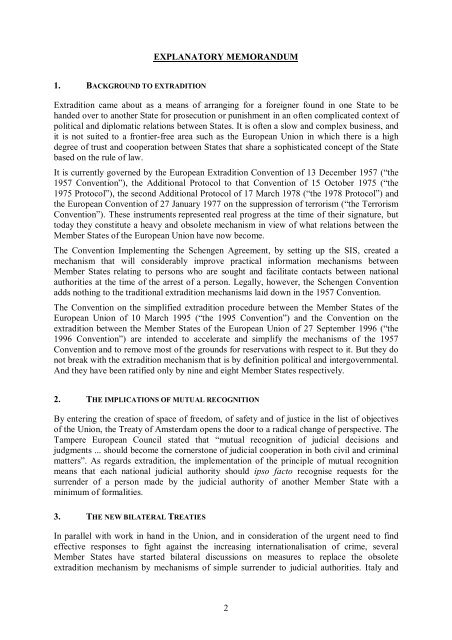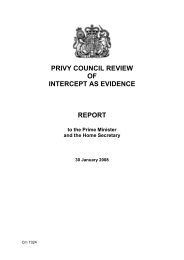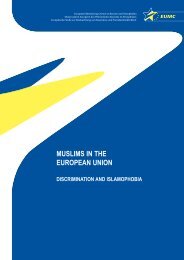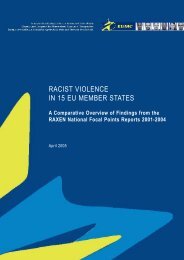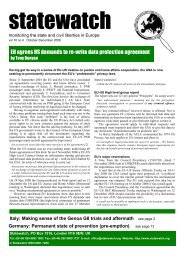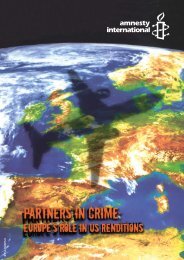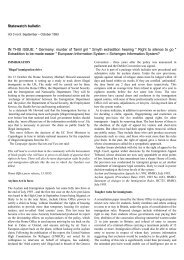the European arrest warrant - Statewatch
the European arrest warrant - Statewatch
the European arrest warrant - Statewatch
Create successful ePaper yourself
Turn your PDF publications into a flip-book with our unique Google optimized e-Paper software.
EXPLANATORY MEMORANDUM<br />
1. BACKGROUND TO EXTRADITION<br />
Extradition came about as a means of arranging for a foreigner found in one State to be<br />
handed over to ano<strong>the</strong>r State for prosecution or punishment in an often complicated context of<br />
political and diplomatic relations between States. It is often a slow and complex business, and<br />
it is not suited to a frontier-free area such as <strong>the</strong> <strong>European</strong> Union in which <strong>the</strong>re is a high<br />
degree of trust and cooperation between States that share a sophisticated concept of <strong>the</strong> State<br />
based on <strong>the</strong> rule of law.<br />
It is currently governed by <strong>the</strong> <strong>European</strong> Extradition Convention of 13 December 1957 (“<strong>the</strong><br />
1957 Convention”), <strong>the</strong> Additional Protocol to that Convention of 15 October 1975 (“<strong>the</strong><br />
1975 Protocol”), <strong>the</strong> second Additional Protocol of 17 March 1978 (“<strong>the</strong> 1978 Protocol”) and<br />
<strong>the</strong> <strong>European</strong> Convention of 27 January 1977 on <strong>the</strong> suppression of terrorism (“<strong>the</strong> Terrorism<br />
Convention”). These instruments represented real progress at <strong>the</strong> time of <strong>the</strong>ir signature, but<br />
today <strong>the</strong>y constitute a heavy and obsolete mechanism in view of what relations between <strong>the</strong><br />
Member States of <strong>the</strong> <strong>European</strong> Union have now become.<br />
The Convention Implementing <strong>the</strong> Schengen Agreement, by setting up <strong>the</strong> SIS, created a<br />
mechanism that will considerably improve practical information mechanisms between<br />
Member States relating to persons who are sought and facilitate contacts between national<br />
authorities at <strong>the</strong> time of <strong>the</strong> <strong>arrest</strong> of a person. Legally, however, <strong>the</strong> Schengen Convention<br />
adds nothing to <strong>the</strong> traditional extradition mechanisms laid down in <strong>the</strong> 1957 Convention.<br />
The Convention on <strong>the</strong> simplified extradition procedure between <strong>the</strong> Member States of <strong>the</strong><br />
<strong>European</strong> Union of 10 March 1995 (“<strong>the</strong> 1995 Convention”) and <strong>the</strong> Convention on <strong>the</strong><br />
extradition between <strong>the</strong> Member States of <strong>the</strong> <strong>European</strong> Union of 27 September 1996 (“<strong>the</strong><br />
1996 Convention”) are intended to accelerate and simplify <strong>the</strong> mechanisms of <strong>the</strong> 1957<br />
Convention and to remove most of <strong>the</strong> grounds for reservations with respect to it. But <strong>the</strong>y do<br />
not break with <strong>the</strong> extradition mechanism that is by definition political and intergovernmental.<br />
And <strong>the</strong>y have been ratified only by nine and eight Member States respectively.<br />
2. THE IMPLICATIONS OF MUTUAL RECOGNITION<br />
By entering <strong>the</strong> creation of space of freedom, of safety and of justice in <strong>the</strong> list of objectives<br />
of <strong>the</strong> Union, <strong>the</strong> Treaty of Amsterdam opens <strong>the</strong> door to a radical change of perspective. The<br />
Tampere <strong>European</strong> Council stated that “mutual recognition of judicial decisions and<br />
judgments ... should become <strong>the</strong> cornerstone of judicial cooperation in both civil and criminal<br />
matters”. As regards extradition, <strong>the</strong> implementation of <strong>the</strong> principle of mutual recognition<br />
means that each national judicial authority should ipso facto recognise requests for <strong>the</strong><br />
surrender of a person made by <strong>the</strong> judicial authority of ano<strong>the</strong>r Member State with a<br />
minimum of formalities.<br />
3. THE NEW BILATERAL TREATIES<br />
Inparallelwithworkinhandin<strong>the</strong>Union,andinconsiderationof<strong>the</strong>urgentneedtofind<br />
effective responses to fight against <strong>the</strong> increasing internationalisation of crime, several<br />
Member States have started bilateral discussions on measures to replace <strong>the</strong> obsolete<br />
extradition mechanism by mechanisms of simple surrender to judicial authorities. Italy and<br />
2


